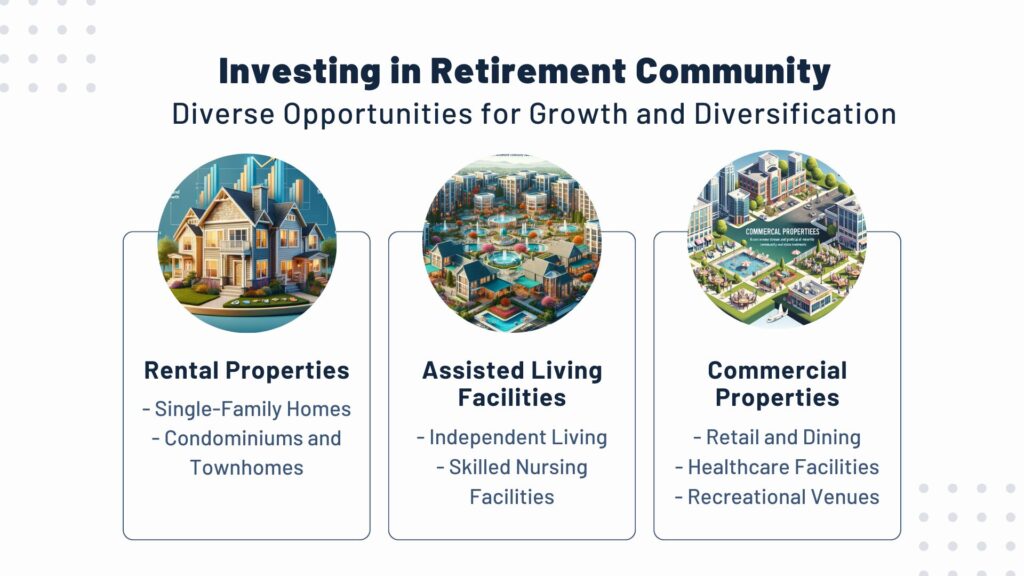As we navigate through life’s journey, retirement often looms as a significant milestone. For many, securing a comfortable and financially stable retirement becomes a top priority. One avenue that deserves attention is real estate investment in retirement communities. This dynamic sector offers a unique blend of opportunity and potential for those seeking diversified income streams and long-term growth.
Understanding the Retirement Community Landscape
The Demographic Shift
The retirement community market is driven by a demographic shift that cannot be ignored. As the baby boomer generation ages, the demand for specialized housing and amenities tailored to their needs continues to rise. Moreover, advancements in healthcare and an emphasis on active lifestyles have contributed to an increasing number of retirees seeking communities that cater to their evolving preferences.
According to the U.S. Census Bureau, the population aged 65 and older is projected to reach 73.1 million by 2030, accounting for nearly 21% of the total population. This demographic trend highlights the growing demand for retirement communities equipped to meet the diverse needs of an aging population.
The Appeal of Retirement Communities
Retirement communities offer a range of attractive features that appeal to individuals seeking a fulfilling post-career lifestyle. From a sense of community and social engagement to accessible healthcare services and recreational amenities, these communities provide a comprehensive living experience. Consequently, retirement communities have become desirable destinations for those seeking a comfortable and enriching retirement.
Community and Social Engagement. One of the primary draws of retirement communities is the opportunity for social interaction and a sense of belonging. These communities foster an environment where residents can participate in various activities, clubs, and events, fostering connections and combating the isolation that can sometimes accompany aging.
Healthcare and Wellness Facilities. Many retirement communities prioritize healthcare and wellness by offering on-site medical facilities, fitness centers, and access to various healthcare professionals. This convenience and accessibility can provide residents with peace of mind, knowing that their healthcare needs are met within the community.
Recreational Amenities. From golf courses and swimming pools to hiking trails and cultural events, retirement communities often boast a wide array of recreational amenities. These amenities cater to diverse interests and promote an active, engaging lifestyle for residents, contributing to their overall well-being.
Click here to learn more and subscribe to the newsletter
Investing in Retirement Community
Investing in retirement communities offers diverse opportunities for diversification and long-term growth. It explores rental properties like single-family homes, condos, and townhomes, as well as assisted living facilities for various care levels. The sector also includes commercial properties such as retail, dining, healthcare facilities, and recreational venues catering to residents’ needs. This overview covers the investment landscape within this evolving industry.

Rental Properties
One of the most straightforward investment opportunities lies in rental properties within retirement communities. As the demand for housing in these communities grows, the potential for steady rental income becomes increasingly appealing. Additionally, many retirees prefer the flexibility and convenience of renting, creating a consistent pool of prospective tenants.
1. Single-Family Homes. Investing in single-family homes within retirement communities can provide a stable source of rental income. These properties often appeal to retirees seeking a more traditional living experience while benefiting from the amenities and services offered by the community.
2. Condominiums and Townhomes. For those seeking lower-maintenance investment options, condominiums and townhomes within retirement communities can be attractive choices. These properties typically offer shared amenities and reduced maintenance responsibilities, making them appealing to retirees seeking a hassle-free lifestyle.
Assisted Living Facilities
For those willing to venture into the realm of assisted living facilities, the investment potential can be substantial. These facilities cater to individuals requiring varying levels of care and support, ranging from independent living to more comprehensive services. With the aging population and the increasing need for such services, investing in well-managed assisted living facilities can yield lucrative returns.
1. Independent Living Facilities. Independent living facilities cater to retirees who are generally self-sufficient but seek the convenience and amenities of a community setting. These facilities often offer various services, such as housekeeping, dining, and social activities, while allowing residents to maintain their independence.
2. Skilled Nursing Facilities. At the other end of the spectrum, skilled nursing facilities provide comprehensive care and medical services for residents requiring more intensive support. These facilities employ trained staff and medical professionals to ensure residents receive the necessary care and assistance.
Commercial Properties
Beyond residential options, retirement communities often encompass a vibrant commercial landscape. From restaurants and retail establishments to healthcare facilities and recreational venues, these commercial properties serve the needs of the community’s residents. Investing in these commercial spaces can provide a diverse revenue stream and the potential for long-term asset appreciation.
1. Retail and Dining Establishments. Retirement communities frequently feature retail stores, restaurants, and cafes to cater to residents’ daily needs and leisure activities. Investing in these commercial spaces can generate steady rental income while providing essential services to the community.
2. Healthcare Facilities. As retirement communities prioritize accessible healthcare, investing in medical facilities, such as clinics, diagnostic centers, or pharmacies, can be a lucrative opportunity. These facilities cater to the healthcare needs of residents and may attract patients from surrounding areas as well.
3. Recreational Venues. Retirement communities often feature various recreational venues, including golf courses, fitness centers, and entertainment facilities. Investing in these properties can tap into the growing demand for active and engaging lifestyles among retirees.
Get your free “2024 Real Estate Market Outlook” now!
Navigating the Investment Process
Conducting Thorough Research
Prior to any investment decision, it is crucial to conduct thorough research on the specific retirement community and its surrounding area. Factors such as population demographics, economic indicators, and competition should be carefully evaluated. Additionally, researching the management team and operational history of the retirement community can provide valuable insights into its potential for success.
Demographic Analysis. Analyzing demographic data is essential to understand the target market and assess the demand for retirement housing and services. Key factors to consider include age distribution, income levels, and lifestyle preferences within the surrounding area.
Economic Indicators. Evaluating economic indicators, such as employment rates, housing market trends, and consumer spending patterns, can provide insights into the financial viability and growth potential of a retirement community investment.
Competitive Landscape. Assessing the competitive landscape is crucial to identify potential challenges and opportunities. Understanding the offerings and pricing strategies of nearby retirement communities can inform investment decisions and help differentiate your property or services.
Building a Solid Network
Establishing a strong network within the retirement community industry can prove invaluable. Connecting with real estate professionals, property managers, and industry experts can unlock valuable insights, potential partnerships, and investment opportunities. Furthermore, cultivating relationships with prospective residents and their families can provide a deeper understanding of their needs and preferences.
Real Estate Professionals. Collaborating with experienced real estate agents, brokers, and developers who specialize in retirement community properties can provide access to exclusive investment opportunities and insider knowledge of the local market.
Property Managers and Operators. Building relationships with reputable property management companies and retirement community operators can offer valuable insights into operational best practices, tenant acquisition strategies, and industry trends.
Industry Associations and Events. Attending industry conferences, trade shows, and networking events can facilitate connections with key stakeholders, including developers, investors, and service providers within the retirement community sector.
Leveraging Professional Expertise
While real estate investing in retirement communities can be rewarding, it is essential to seek professional guidance. Working with experienced real estate agents, attorneys, and financial advisors can help navigate the complexities of the investment process. These professionals can provide valuable advice on structuring deals, minimizing risks, and maximizing returns.
Real Estate Agents and Brokers. Engaging the services of a knowledgeable real estate agent or broker can streamline the property search and acquisition process. Their expertise in evaluating properties, negotiating deals, and navigating legal requirements can be invaluable.
Attorneys and Legal Professionals. Consulting with attorneys who specialize in real estate law can ensure compliance with relevant regulations, protect your interests, and guide you through complex legal matters associated with retirement community investments.
Financial Advisors and Accountants. Collaborating with financial advisors and accountants can help develop effective investment strategies, optimize tax implications, and manage the financial aspects of your retirement community investments effectively.
Conclusion
In conclusion, real estate investment in retirement communities presents a compelling opportunity for those seeking diversification and long-term growth. By understanding the market dynamics, exploring various investment avenues, and navigating the process with diligence and professional guidance, investors can position themselves for success in this evolving and promising sector. However, it is crucial to conduct thorough research, analyze market trends, and seek expert advice to mitigate potential risks and make informed decisions. Additionally, maintaining a well-diversified portfolio and adopting a long-term perspective can contribute to financial stability and sustained growth. With careful planning and execution, investing in retirement communities can offer the potential for attractive returns while catering to the evolving needs of an aging population.
Interested in multifamily real estate investing? Our experienced team is here to help. From market research to identifying the best opportunities, we guide you through the process. Subscribe to our YouTube channel for informative videos and expert discussions, and follow us on Instagram for exclusive content. Explore our comprehensive Udemy course for detailed insights and strategies. Ready to elevate your investment journey? Contact us now to schedule a consultation and achieve your financial goals in real estate.
*This content is for informational purposes only and is not intended as financial or legal advice. Please consult with a professional advisor before making any investment decisions.




























